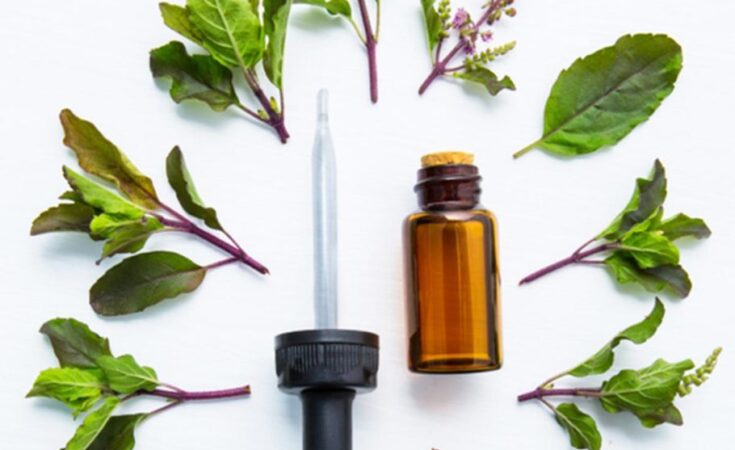Essential oils (EOs) are volatile aromatic oils extracted via mechanical pressing (cold-pressed) or steam distillation of plant parts, such as leaves, roots, stems, flowers, and bark (1) (2). These concentrated extracts have been used in aromatherapy and folk medicine to treat and manage ailments such as cold, flu, and insomnia (2).
Since EOs are natural products that possess therapeutic properties, you may want to use them to maintain your child’s health and treat illnesses. But are essential oils safe for children? Ascertaining this is vital to avert the risk of any adverse effects, such as allergic reactions.
Read on to learn more about the safe and unsafe essential oils for children and their possible uses and side effects.
Are Essential Oils Safe For Children?
When used appropriately and under the guidance of an expert, most EOs are safe for children. You may consult a herbalist, essential oil practitioner, or alternative medicine expert to learn about the suitable oils for your child.
Based on the child’s age, the intent of use, and medical condition, the expert can guide you on the safe EOs for your child (3). They can also suggest the proper dosage and suitable mode of use.
What Is The Right Age To Use Essential Oils For Children?
Essential oils are not recommended for children below three months. Beyond this age, the use of EOs relies on the child’s age, usage intent, and method of use. For instance, you can safely use chamomile (German and Roman) EO for topical and diffusion purposes in children above three months. But, the topical use of clove oil in children under two years of age isn’t advisable. Likewise, the use of rosemary and eucalyptus EOs isn’t advisable through any mode for children under ten years (4).
Which Essential Oils Are Considered Safe For Children?
Chamomile, dill, lavender, bergamot, cedarwood, cinnamon, tea tree, mandarin, and neroli are a few EOs that children above six months can use for topical application and diffusion. Besides these, here’s a list of some EOs that are considered safe for topical use and diffusion purposes on children based on their age (4).
| Safe EOs 2+ years onwards | Safe EOs 6+ years onwards | Safe EOs 10+ years onwards |
|---|---|---|
| Basil (lemon and sweet)
Clary sage Lemongrass Lime Ginger Oregano Sweet Marjoram Patchouli Spearmint Tea Tree, Lemon Thyme Ylang Ylang |
Cardamom
Star Anise Fennel, sweet and bitter Marjoram (Spanish) Niaouli Nutmeg Peppermint Sage (Greek/White) |
Peppermint
Eucalyptus Rosemary |
Keep these points in mind while using Eos for children.
- Use lemongrass, thyme, nutmeg, and peppermint EOs in small amounts for topical applications as they may cause skin irritation if not diluted well.
- Use no more than ten drops of essential oil per ounce of carrier oil for children under six.
- For children above six years, limit the pure essential oils to 20 drops per ounce of carrier oil for topical application.
Note: The American Academy Of Pediatrics (AAP) prohibits oral use of EOs for babies and children, as certain EOs can be toxic when ingested (4).
Which Essential Oils Are Unsafe For Children?
Hyssop and Massoia EOs aren’t safe (all routes) for children under two years of age. Similarly, fennel (sweet and bitter), galangal, and marjoram (Spanish) aren’t safe for children under six years. Further, birch (sweet), chaste tree, and wintergreen EOs are unsafe for children across age groups (4).
Uses Of Different Essential Oils For Children
Several essential oils have demonstrated antimicrobial, anti-inflammatory, and antioxidant properties and even psychogenic effects (5). These properties allow EOs to be used in the treatment of ailments in complementary and alternative medicine.
For instance, peppermint EO can help treat headaches, nausea, and fatigue in children above 30 months. Similarly, basil and citronella can work as insect repellents in children above six months (6). On the other hand, lavender, chamomile, basil, and frankincense can help alleviate stress and anxiety and promote good sleep.
Potential Drawbacks Of Essential Oils
Before using EOs for your child, stay informed about some of their possible side effects (7).
- Skin irritation and inflammation: Experts advise diluting essential oils with a carrier oil before their topical application. This is vital as EOs are concentrated extracts that can cause skin inflammation and irritation when used undiluted. Some essential oils need more dilution than others, so it’s crucial to consult a professional herbalist or alternative medicine expert before applying EOs on children.
- Photosensitivity: Some EOs contain compounds such as furocoumarins, coumarins, and linalool that can cause photosensitivity (8), leading to red, itchy skin with burns and blisters that may cause permanent skin discoloration. So, avoid using EOs before you step out in the sun. Citrus oils are known to cause photosensitivity.
- Allergic reactions: EOs can trigger an allergy in sensitive children, so use EOs for children with the utmost care and only under expert guidance. If you are using EO topically for the first time, do a patch test using diluted EO on a small area, such as the back of your child’s hand or elbow to ascertain the EOs safety for your child. Discontinue EO use if your child looks uncomfortable or shows symptoms of an allergy, such as skin rashes (hives), coughing, vomiting, headaches, or seizures.
- Possible drug interaction: EOs contain several bioactive compounds that could interact with certain drugs. So, if your child is on any medications or herbal supplements, inform the expert before they guide you on the appropriate type and dosage of EO for the child.
- Cross-reactivity: Essential oils can cross-react. For instance, if your child is allergic to ragweed, they may be allergic to chamomile too (3). So, get all the relevant information about the EO you intend to use.
- Hormonal changes: Studies show that EOs such as lavender oil and tea tree oil contain chemicals that mimic human hormones and act as endocrine disruptors. The topical use of these EOs may trigger prepubertal gynecomastia in boys (1).
Things To Consider Before Using Essential Oils
Consider these crucial points before using essential oils for your child (6) (9).
- Although essential oils are natural products, it doesn’t necessarily mean they are safe. Unguided use of EOs can have adverse effects on a child’s health. So, consult an essential oil expert who can guide you on the right type and dosage of the oil.
- Some essential oils are safe for topical use, while others are safe for diffusion. So use EOs keeping the mode of use into consideration. Similarly, some EOs may be safe to use for a longer duration when used in minimal amounts, and some for a shorter period.
- Different essential oils have different chemical compositions, and every EO works differently. Thus, always consult an expert to know which EO will suit your child.
- Essential oils are natural extracts that should be used in their pure form. So, always buy pure essential oils. Avoid old, impure, contaminated EOs as they can have adverse reactions, such as skin irritation or allergy. Read the product label thoroughly and avoid synthetic and diluted EOs.
Precautions To Take While Using Essential Oils For Children
Here are some precautions that you must observe to ensure safe use of EOs for your child (6) (9).
- Buy EOs from a trusted and reputable brand. It is necessary to ensure the EO’s quality and avert risks associated with cross-contamination. Pure EOs are relatively expensive, but you can be convinced about their safety.
- Read the label carefully and look for details, such as the plant’s general/Latin name, country of origin, extraction method (steam distilled or cold-pressed), and details of the plant part, such as leaf or flower, used to extract the oil. Knowing these things is vital to ascertain the EO’s authenticity.
- Use essential oils for topical or diffusion purposes. Its ingestion can cause adverse effects. For topical use, you may add diluted EO in your child’s bath water or apply EOs mixed with cream for skincare or body massage. Similarly, you can diffuse EOs using a diffuser or make an EO spray/spritz. In whichever way you use EO, remember to dilute it with a carrier oil, unscented cream, distilled water, or lotion.
- Follow the dilution ratio diligently. For most EOs, mixing three to six drops of an EO in one ounce of base oil is considered a safe dilution ratio. However, the safe ratio may vary for children and range from 0.5 to 2.5 percent. The correct dosage is decided based on the child’s age, weight, and health condition.
- Abstain from overusing to avert possible adverse effects, such as permanent skin damage. Use essential oils sparingly within the recommended dosage only.
- Use hydrosols instead of EOs for children with sensitive skin. Hydrosols or flower water are by-products of distillation done to obtain EOs. Since they primarily contain water and have minimum plant compounds, they are safer than concentrated EOs (10). However, they might not be as effective as EOs.
- Never apply EOs directly on bruised, damaged, or inflamed skin as it may cause unwanted skin reactions. Similarly, avoid using EOs around delicate body parts, such as the eyes, nose, and mouth, to mitigate the risk of accidental ingestion or transfer.
- Always diffuse EOs in a well-ventilated area. Doing so ensures the fumes released by the diffuser properly disperse in the air. In addition, ensure the room has an immediate exit point so that if the child feels uncomfortable due to diffusion, they may leave the room immediately.
- Never diffuse EOs for an extended duration. You should ideally diffuse EOs for 15 to 30 minutes with proper intervals. Prolonged exposure to EO can cause sensitive children to feel tired, lethargic, and nauseous (11).
- Avoid using EO diffusers for children with respiratory conditions, such as asthma, unless an expert advises otherwise. If you happen to use EO diffusion, keep it away from the child and use humidifiers or diffusers only in large, well-ventilated spaces.
- Store EOs in dark or tinted glass containers in a cool, dry, dark place and away from heat and sunlight to maintain their quality. Keep the storage locked or hidden from children to avoid accidental ingestion.
- Contact the nearest poison unit or medical emergency department immediately if your child accidentally ingests an EO. Refrain from self-treatment, such as inducing vomiting. However, if EO accidentally gets into their eye, you can clean it promptly with cold water. Alternatively, you can soak a cotton cloth in olive/sesame oil and gently clean the eye/eyes with the eyelids closed.
Note: EOs are highly combustible, so never put them near fire sources such as gas stoves, candles, and cigarettes.
Essential oils are concentrated, aromatic substances that you can use for children’s general care or treatment of an illness. For safe use, seek expert guidance and observe all safety precautions. Use EOs as directed and avoid their overuse to mitigate adverse effects on your child’s health and well-being.
References:
MomJunction’s articles are written after analyzing the research works of expert authors and institutions. Our references consist of resources established by authorities in their respective fields. You can learn more about the authenticity of the information we present in our editorial policy.



































